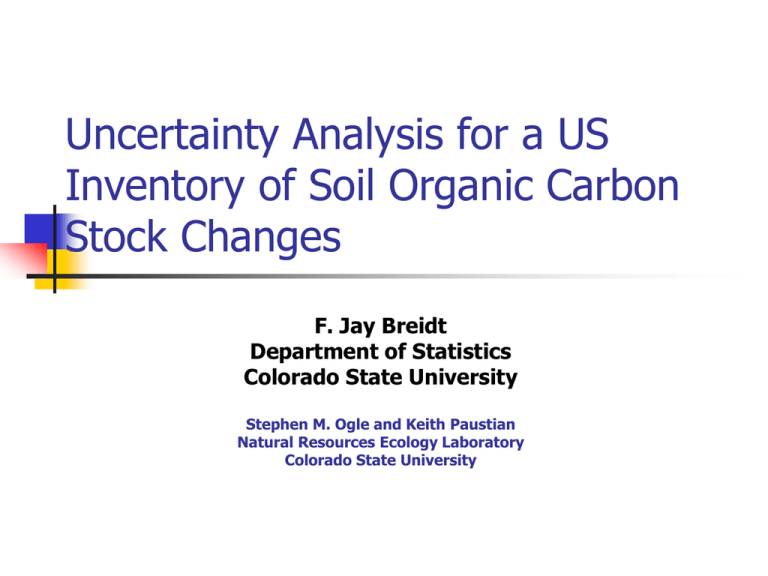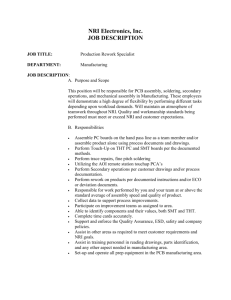Uncertainty Analysis for a US Inventory of Soil Organic Carbon Stock Changes
advertisement

Uncertainty Analysis for a US Inventory of Soil Organic Carbon Stock Changes F. Jay Breidt Department of Statistics Colorado State University Stephen M. Ogle and Keith Paustian Natural Resources Ecology Laboratory Colorado State University Why Inventory Soil Carbon Stocks? Solar energy transmitted to earth as visible and ultraviolet radiation Radiation absorbed by surface gets re-radiated as infrared Greenhouse Gases (GHGs) pass visible and UV, but trap infrared: greenhouse effect include (among others) water vapor, methane, nitrous oxide, CO2 Atmosphere Surface Reflected 25% 5% Absorbed 25% 45% Carbon Sequestration Lithosphere: fossil fuels, limestone, dolomite, chalk Oceans: shells, dissolved CO2 Biosphere: organic molecules in living and dead organisms Soils: organic matter Agricultural Management and Carbon Storage Tillage, fertilization, irrigation, etc. all affect carbon storage Century, a biogeophysical process model, describes site-specific dynamics in an agricultural system tracks carbon, water, nutrient cycling over long time scales (centuries to millennia) requires inputs on soils, weather, agricultural management deterministic output for given inputs cx k , z1k Carbon Dynamics in Century Metherell, Harding, Cole, & Parton 1993 Inventory Goal Estimate total carbon stock change for US agricultural soils, 1990-2004 Report to United Nations Framework Convention on Climate Change pre-Kyoto agreement; nearly universal Use Century to model carbon stock change across US need Century inputs on nationally-representative set of sites in US agricultural lands USDA National Resources Inventory (NRI) • Nationally-representative set of sites in US agricultural lands • Stratified two-stage area sample • Fine stratification with two primary sampling units (PSUs=quarter sections) for every 1/3 township • Three secondary sampling units (points) per PSU • Many points have • same county, MLRA, weather • same categorical values of cropping history, soil, etc. • Run Century at NRI “superpoints” NRI Handles Sampling Uncertainty NRI is a nationally-representative probability sample straightforward and unbiased expansion of point-level data to national total carbon stock change consistent design-based variance estimation and valid confidence intervals NRI contains many key Century inputs site-level cropping history, soil properties Input Uncertainty Not all needed Century inputs are in NRI Weather: (but treat as known from PRISM: local interpolation of station data) Tillage: use county-level Conservation Technology Information Center data Organic amendments: use county-level USDA Manure Management Database Fertilizer: use county-level USDA-ERS Cropping Surveys Tillage Traditional Tillage: after harvest, field contains crop residues tillage turns over the soil to bury residues often repeated several times prior to planting Conservation Tillage: Reduced-Till: limited tillage; substantial crop residues on surface No-Till: doesn’t use tillage; all crop residues left on surface Tillage Input Distribution Conservation Technology Information Center (CTIC) collects county-level information construct discrete distributions for Monte Carlo (CTCT, CTRT, CTNT, RTRT, RTNT, etc.) draw from these distributions to reflect uncertain inputs Photo courtesy of USDA Organic Amendments and Fertilizer Organic amendments and fertilizer not included in NRI Use USDA Manure Management Database county-level data construct distributions for Monte Carlo combine with USDA-ERS cropping survey information to account for negative correlation with fertilizer Artwork courtesy of the Wisconsin Department of Natural Resources Model Uncertainty Century is imperfect For some long-term experimental sites, have measured carbon stock changes modeled carbon stock changes from Century complete set of inputs, plus additional covariates Adjust using regression of measured on modeled Measured Carbon Stock at Long-Term Experiment Sites Measured vs. Modeled 95 Bare-Summer 85 Fallow Set-Aside Lands (CRP) No-Till 75 Sqrt Measured Soil Organic C Stock (g/m2) 65 55 45 35 25 95 85 Hay/Pasture in Annual Cropping Rotation 25 Hay/Pasture in Annual Cropping Rotation w/ Organic Amendments 75 65 55 45 35 25 95 85 Organic Amendments Other Cropping Practices 75 65 55 45 35 25 25 35 45 55 65 75 85 95 25 35 45 55 65 75 Sqrt Modeled Soil Organic C Stock (g/m2) 85 95 35 45 55 65 75 85 95 Adjusted Century Output Experiment sites estimated from data yk f cx k , z1k , z 2 k , θ k measured carbon stock error with dependence from repeated measures known covariates No attempt to estimate Century rate parameters from these data (very high dimension) Expansion to National Total ~ Ideal expansion estimator 1 kNRI k f cx k , z1k , z 2 k , θ known covariates Feasible ˆr kNRI r th replicate estimate of national total 1 k f cX rk , z1k , z 2 k , θˆ r MC from modeled distribution MC from sampling distribution Complete Uncertainty Analysis Framework correlated (sampling) Cropping History Combining Design and Monte Carlo Uncertainties Define second-order inclusion prob: kl Prk , l NRI design covariance: kl kl k l MC expectation:k E f cXk , z1k , z 2k , θˆ MC covariance: kl Cov f cXk , z1k , z 2k , θˆ , f cXl , z1l , z 2l , θˆ Unconditional variance input uncertainty model uncertainty 1 Var f cX k , z1k , z 2 k , θˆ kNRI k sampling uncertainty kl k l kl kl : V k l k l kU kU Variance Estimation Combination of MC replication and design-based methods for 2 R R (unreplicated) sample ˆr2 ˆr R usual MC variance estimate r 1 ˆ r 1 V1 usual design-based variance estimate for MC averages (SAS proc surveymeans or PCCARP once) Vˆ2 R 1 2 f c X rk , z1k , z 2 k , θˆ r kl r R RR 1 k ,lNRI kl R f c Xlr ' , z1l , z 2l , θˆ r ' r ' k l R average of design-based variance estimates across MC reps (SAS proc surveymeans or PCCARPR times) r R ˆ r f c X r , z , z , θˆ r f c X , z , z , θ 1 kl k 1 k 2 k l 1l 2l Vˆ3 RR 1 r 1 k ,lNRI kl k l Variance Estimation, Continued Unbiased estimator of V is then Vˆ Vˆ1 Vˆ2 Vˆ3 But note that 2 2 2 N N N , E Vˆ2 O , E Vˆ3 O E Vˆ1 O n n Rn Simpler (saves R variance computations), conservative estimator * ˆ V Vˆ1 Vˆ2 Implementation n=123K NRI superpoints in cropland, from almost 1M total NRI points R=100 MC reps for each NRI superpoint 12.3M Century runs Compute estimates and uncertainties at national level as well as for interesting domains National-Scale Century Inventory Results (Tg CO2 Eq.) Soil Type 1990-1994 1995-2004 (71.24) (62.52) (69.7) to (73.0) (60.9) to (64.2) 1.47 (2.82) 0.7 to 2.2 (2.2) to (3.3) (8.25) 3.96 (6.2) to (10.3) 2.2 to 5.5 (12.80) (15.99) (12.5) to (13.2) (15.8) to (16.1) Mineral Soils Croplands Remaining Croplands 95% C.I. Lands Converted to Croplands 95% C.I. Grasslands Remaining Grasslands 95% C.I. Lands Converted to Grasslands 95% C.I. Summary National inventory of carbon stock changes, using variety of data sources Combine Monte Carlo and design-based methods to account for sampling uncertainty input uncertainty model uncertainty First phase in ongoing study Future improvements: Incorporate remote sensing data for estimating crop and forage production Account for emissions of N2O associated with agricultural management




